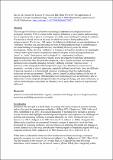Files in this item
The application of resilience concepts in palaeoecology
Item metadata
| dc.contributor.author | Davies, Althea L. | |
| dc.contributor.author | Streeter, Richard T. | |
| dc.contributor.author | Lawson, Ian T. | |
| dc.contributor.author | Roucoux, Katherine H. | |
| dc.contributor.author | Hiles, William | |
| dc.date.accessioned | 2018-06-13T14:30:05Z | |
| dc.date.available | 2018-06-13T14:30:05Z | |
| dc.date.issued | 2018-09-01 | |
| dc.identifier | 251882036 | |
| dc.identifier | 06b9eed1-a84a-40c8-bb00-06e0f449d654 | |
| dc.identifier | 85048983581 | |
| dc.identifier | 000443315700012 | |
| dc.identifier.citation | Davies , A L , Streeter , R T , Lawson , I T , Roucoux , K H & Hiles , W 2018 , ' The application of resilience concepts in palaeoecology ' , The Holocene , vol. 28 , no. 9 , pp. 1523-1534 . https://doi.org/10.1177/0959683618777077 | en |
| dc.identifier.issn | 0959-6836 | |
| dc.identifier.uri | https://hdl.handle.net/10023/14018 | |
| dc.description.abstract | The concept of resilience has become increasingly important in ecological and socio-ecological literature. With its focus on the temporal behaviour of ecosystems, palaeoecology has an important role to play in developing a scientific understanding of ecological resilience. We provide a critical review of the ways in which resilience is being addressed by palaeoecologists. We review ~180 papers, identifying the definitions or conceptualisations of ‘resilience’ that they use, and analysing the ways in which palaeoecology is contributing to our understanding of ecological resilience. We identify three key areas for further development. Firstly, the term ‘resilience’ is frequently defined too broadly to be meaningful without further qualification. In particular, palaeoecologists need to distinguish between ‘press’ vs. ‘pulse’ disturbances, and ‘ecological’ vs. ‘engineering’ resilience. Palaeoecologists are well placed to critically assess the extent to which these dichotomies apply in real (rather than theoretical) ecosystems, where climate and other environmental parameters are constantly changing. Secondly, defining a formal ‘response model’ - a statement of the anticipated relationships between proxies, disturbances and resilience properties - can help to clarify arguments, especially inferred causal links, since the difficulty of proving causation is a fundamental limitation of palaeoecology for understanding ecosystem drivers and responses. Thirdly, there is a need for critical analysis of the role of scale in ecosystem resilience. Different palaeoenvironmental proxies are differently able to address the various temporal and spatial scales of ecological change, and these limitations, as well as methodological constraints on inherently noisy proxy data, need to be explored and addressed. | |
| dc.format.extent | 12 | |
| dc.format.extent | 1045909 | |
| dc.language.iso | eng | |
| dc.relation.ispartof | The Holocene | en |
| dc.subject | Disturbance regime | en |
| dc.subject | Ecosystem dynamics | en |
| dc.subject | Ecosystem modelling | en |
| dc.subject | Environmental change | en |
| dc.subject | Palaeoenvironmental | en |
| dc.subject | Socio-ecological systems | en |
| dc.subject | G Geography (General) | en |
| dc.subject | GE Environmental Sciences | en |
| dc.subject.lcc | G1 | en |
| dc.subject.lcc | GE | en |
| dc.title | The application of resilience concepts in palaeoecology | en |
| dc.type | Journal item | en |
| dc.contributor.institution | University of St Andrews. School of Geography & Sustainable Development | en |
| dc.contributor.institution | University of St Andrews. Bell-Edwards Geographic Data Institute | en |
| dc.identifier.doi | https://doi.org/10.1177/0959683618777077 | |
| dc.description.status | Peer reviewed | en |
This item appears in the following Collection(s)
Items in the St Andrews Research Repository are protected by copyright, with all rights reserved, unless otherwise indicated.

